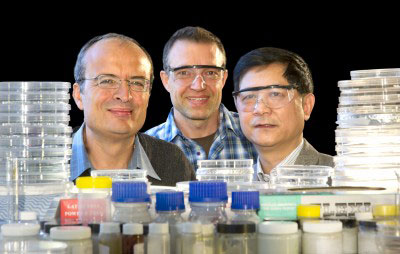| Aug 09, 2011 |
Funding boost for printable solar cells project
|
|
(Nanowerk News) A new form of low-cost solar cell that can be printed onto plastic and metal is a step closer to production after the State and Federal Governments announced a boost in funding for the ongoing research project.
|
|
Martin Ferguson, Federal Minister for Resources and Energy and his Victorian counterpart, Michael O'Brien jointly announced the additional $3.4 million in funding to assist in the development of the printing technology.
|
|
Professor Yi-Bing Cheng and Professor Udo Bach, from Monash University's Faculty of Engineering, together with Professor Leone Spiccia from the Faculty of Science are part of the Victorian Organic Solar Cell Consortium (VICOSC) in partnership with the University of Melbourne, the CSIRO and industry partners.
|
 |
| Professors Leone Spiccia, Udo Bach and Yi-Bing Cheng
|
|
The technologies developed by VICOSC utilise titanium oxide and light-sensitive ink, which are printed directly onto polymers or metal. The lightweight nature of the cells mean they could be used for a number of applications beyond roofing, including mobile solar sources.
|
|
Mr Ferguson said the funding would help move the project from the research to the development phase.
|
|
"Using low-cost and readily available organic materials to print solar cells through established industrial processes where we already have a competitive advantage offers the potential for solar cells to be manufactured at low-cost in Australia.
|
|
"Australia is a leader in solar energy research and projects such as this will help Australia remain at the forefront of this rapidly growing industry," said Mr Ferguson.
|
|
Professor Cheng welcomed the additional funding and said it highlighted the importance of the research.
|
|
"The main barrier to the uptake of solar technology to date has been cost. Conventional solar cells use silicon as a base and that's quite expensive.
|
|
"The technology we're developing can be printed on plastics or metal and this will reduce the manufacturing costs. Potentially, this development has the ability to significantly increase the uptake of solar technology in Australia."
|
|
Professor Cheng said the innovative research was a good example of the future of Australia's employment strengths.
|
|
"As we move to a low-carbon economy, many of our green jobs are going to come from research and technology innovation. We're really pleased that the government is recognising this and supporting this trend."
|

